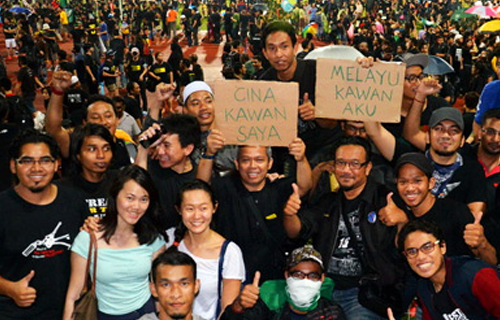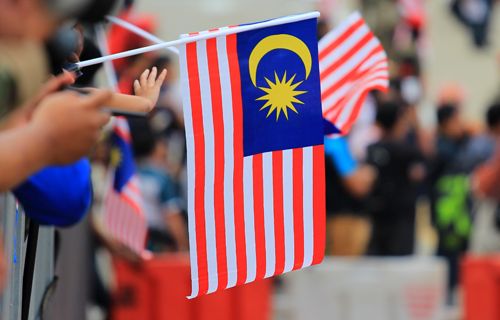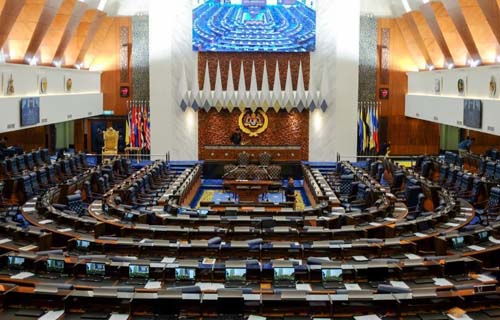You Apa?: Questions Multiracial Malaysians Have To Put Up With

Written by Jananie Chandrarao, a member of Akar Umbi Kita, a programme for emerging advocates against racial discrimination by Architects of Diversity, Imagined Malaysia, IDEAS and the European Union. This article is published in conjunction with the International Day for the Elimination of Racial Discrimination.
“In every lecture, I go to, the first thing I’m asked by my lecturers is ‘You apa?’”, recalls Pavitra a 23-years old Chindian undergraduate. Her reply proclaiming her Indian identity is often met with ‘Bukan macam Hindu pun’. Each time this scenario repeats itself, Pavitra was left feeling more uncomfortable and unsettled. The question of ‘What are you?’ made her feel like an object to be analysed by the gaze of others.
It was not about what they asked, it was about the way they asked. All that she is to, reduced to a single word statement. It was how she has to look a certain way to be enough; Indian enough. The lived experiences of Malaysian Chindians proves the need for more kindness and curiosity towards multiracial individuals.
Chindian is an informal term used for those who have mixed heritage, specifically Indian and Chinese heritage. Although Chindians are biracial individuals, they are forced to actively choose only one part of their identity in official documents and forms or resort to labelling themselves as “Lain-lain”.
Cambridge dictionary defines race as “one of the main groups to which people are often considered to belong, based on physical characteristics that they are perceived to share such as skin colour, eye shape, etc”. However, many Chindians, whose complexion is lighter than Indians and darker than Chinese, sometimes resemble a person of a Malay ancestry. But if race means someone belongs to a certain group for looking alike, would shoving Chindians into the Malay category make sense?
It doesn’t. Yet this is a common experience for Chindians who look like Malays in many spaces.
For the purpose of this article, I have interviewed three Chindian individuals on their daily life experiences pertaining to their identity as well as their unique experiences as biracial individuals. This is so that this opinion piece would accurately represent the lived experiences of my Chindian friends as the author is not a Chindian.
Elsie, a 25-year old Chindian, recalls being mistaken for a Malay girl, only at a very young age.
“When I was at primary school, people actually mistook me for a Malay student. I also sat for agama classes and took one of the papers until one day, my mum found that it was weird that I was failing only one subject, which was agama. When my mum asked the 7-year old me why I was attending theseclasses, I could only say ‘Ma, I’m a Muslim’. I can still remember her laughing upon hearing this”.
It is the silliest mistake a teacher can make, but it happened. It happened to Elsie.
For Pavitra, her experiences of being presumed as Malay was much harsher.
“During Ramadan, if I was eating or drinking something, people look down on me. And my family and I have been verbally insulted in public because we were eating during Ramadan”.
For Pavitra, experiences like this are very dangerous and harmful. She expressed her concern for her and her family’s safety if the perpetrator was even a little violent. This was not the first time she was publicly shamed. Having been mistaken for a Malay girl, she was also shouted at by an Ustaz in the middle of the field for walking with her male friend. Such incidents cause so much hurt and damage to biracial individuals where their identity is always presumed.
On top of being shoved into the Malay category, Chindians also experience racial discrimination based on either their Chinese or Indian identity too. For Elsie, she witnessed a Chinese girl child being scolded for holding the same pole as she did by her mother on an LRT. To her shock, the girl child was told in Mandarin how Indians were smelly people. Given that it is not unusual for Chindians to be able to converse in Mandarin, hearing oneself being bad-mouthed in a language others assume they don’t understand is an incredibly unpleasant experience.
Biracial or multiracial individuals often have a hard time navigating through their identity development too. Ragavi shared her experience of feeling always in the middle; feeling half and half given her biracial identity. She recalls struggling to retain both of her Chinese and Indian identities around her Chinese or Indian relatives because they often forget she is mixed. “It feels like I have multiple personalities”, she chuckled. Sometimes, one race’s bias on the other race portrayed by her own relatives feels like a big part of her identity denied or shamed. On the other hand, having to change parts of herself to fit in or prioritise one part of her identity over another leaves her with intense guilt.
When asked about her multiracial identity, Elsie shared a poem she wrote.
“Where do I fit in when my skin is caramel but speaking Mandarin is so effortless? Where do I fit in when I know how to pleat and drape a saree but ayam masak lemak cili padi is what I would pick out of any variety? Where do I fit in when I celebrate all three Deepavali, Christmas and Chinese New Year but I’m told to wear my pottu to make the fact that I’m Indian clear?”
Elsie’s poem adds clarity to how complex one’s identity can be.
Identities are shades of grey. Somewhere between bright white and dark black that does not have definite labels. They cannot be forced into boxes and compartmentalized by our brains. Even basic colours have their own complexities and yet we as humans are made to choose between choices of ‘Melayu, India, Cina’ or ‘Lain-lain’, we are made to be reduced to mere labels.
There’s nothing wrong with wanting to know, with being curious. What is dangerous are making assumptions and acting on them with self-righteousness. Imagine how easily all of these unpleasant experiences of our multiracial brothers and sisters would not have taken place if we could just ask who they were. I wonder how hard it would have been for us to be a little kinder? Instead of asking ‘You apa?’, we could perhaps be more polite. ‘You look different. May I ask if you are mixed?’ would have been a better alternative.
Names of all interviewees have been changed to protect their identities.


